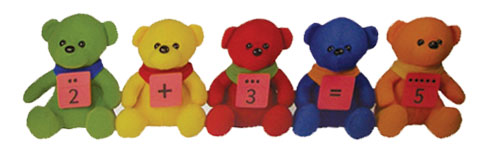publication date: Mar 3, 2010
 Here are zoobookoo.com's top ten tips:1. Get real!
Here are zoobookoo.com's top ten tips:1. Get real!From a
young age and at every opportunity
encourage your child to
count out loud: for example apples on a plate. Build up to
working out how many
items you need to buy: if there are
four in your family, and you each
eat two apples in a week,
how many do you need for the week? Extend this to working out
how many miles to go when travelling and other
every day situations.2. Number line This is a line with
numbers - usually to
20 to begin, continuing higher in schools. It
visually demonstrates increasing and decreasing
quantities. Make your own on a
large sheet of paper – it could be a
colourful snake, a long scarf etc, and work through l
ots of examples saying if you start on six and
add two how many do we have? Try
subtracting too.
3. Number bonds These are as
vital in the early days as the
times tables are later. For instance
number bonds to 5 would be 1+4, 2+3, 3+2, 4+1 and 5+0. They form a
building block for the harder sums. See below for a useful list of number bonds for various ages.
Ensure your children know their number bonds
by heart.
4. Times tablesProbably the
most important building block in a child's
numeric development, times tables form a key stone to all other
mathematical challenges, not to mention incredibly useful in real life.
Chant them, sing them, forwards,
backwards, test each other, practice the
easy ones they may have forgotten. Make them second nature for them - this is a
gift for life.5. Activity place matsBefore the
meal and after you can have fun with
write-on wipe off activity maths mats – available for all ages. There are even some
Magic Mats which have
invisible answers that the children can reveal by rubbing a magic box with their finger (see below for details). This can buy you
valuable time to prepare dinner!
6. Dice gamesKeep a
dice game in your bag for those"‘waiting" moments in
restaurants or at the doctors.
Dice games are great fun and are
wonderful for reluctant mathematicians (
education by stealth).
7. Think in 10sYou may do this
instinctively but if not then start now. So 22 plus 13 is
22 plus 10 plus 3. Or 58 minus 39 is 58 minus 40 plus 1. It is so much
easier to take away or add
quickly in 10s and then add or minus the
single digits.
8. Height chartRun a
height chart at home. Make or buy one. Discuss
growth, working out the amount
grown and the differences between
siblings and
parents. Ask relatives and friends to be measured.
9. Pocket moneyWhen your child is of an
age to understand the concept of
pocket money, run a
points system. Points are gained through the week for
good behaviour, special moments of kindness or
thoughtfulness, tidying up etc and they are
lost for poor behaviour,
nastiness etc. Each point is worth so many
pennies. You can gear the system to arrive at a figure you feel is
reasonable for
pocket money. 10. Maths for parents
Many schools and colleges offer various free "
maths for parents" courses. Get involved! This is a great way to
understand how and what your child is learning. It's
not the same as it was back in our day!
For helpful
numeracy resources for parents and carers visit
www.zoobookoo.com
